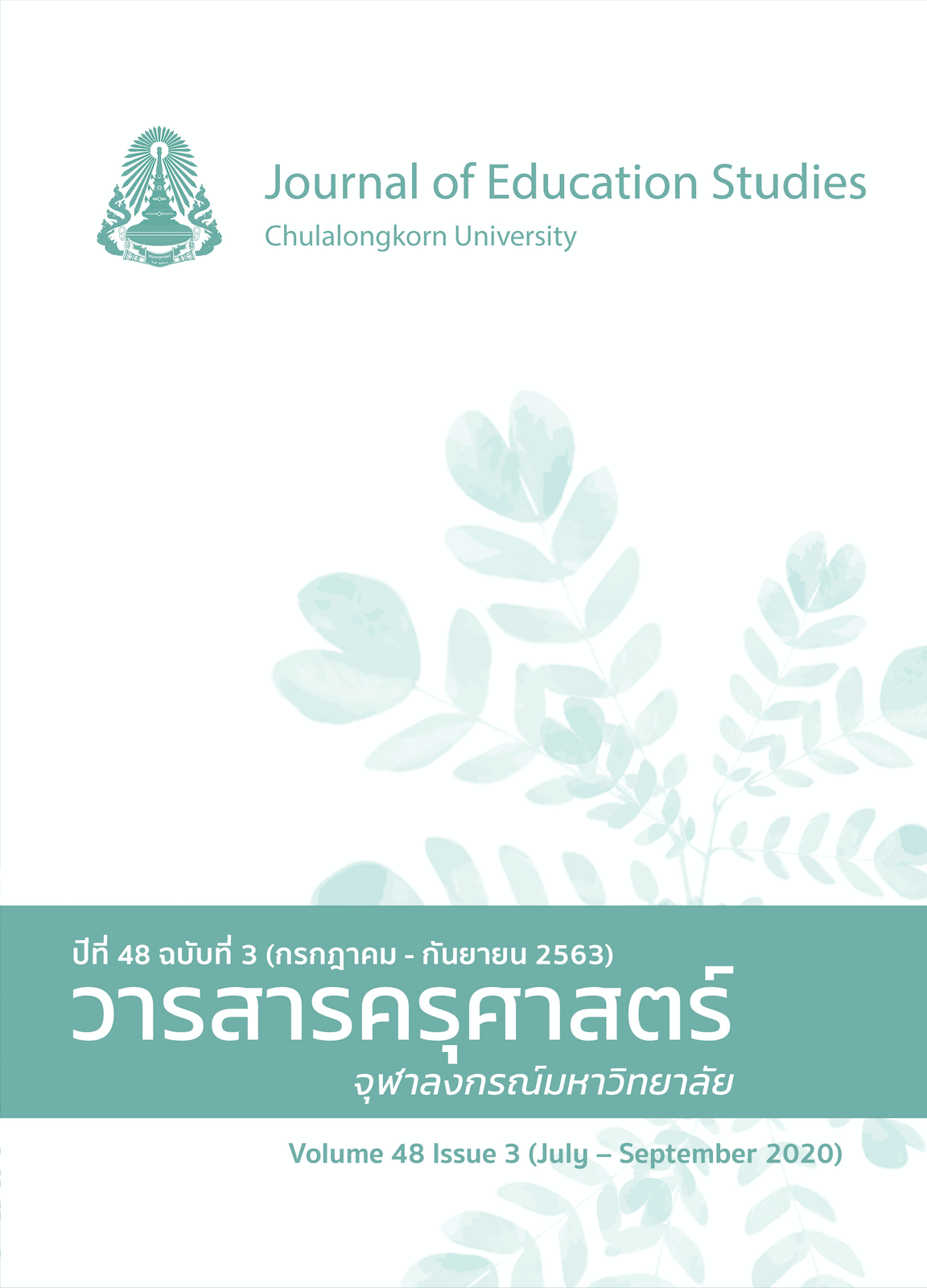Development of an Instructional Model Using Design Thinking Approach to Create Thai Identity Products for Undergraduate Students
Keywords:
design thinking, Thai identity, creative Thai products, design educationAbstract
This research aimed to develop and study the effectiveness of a model with the sample groups of 36 second year students in design education division, King Mongkut's Institute of Technology Ladkrabang. Research tools included; instructional model, teaching plans, scoring rubrics and questionnaires. Experiment design was one group pretest – posttest design. Design tasks were three Thai identities using different exercises; Hanuman, Ravana, and Garuda VS Naga. Art works of Thai identities on before and after class were assessed by three experts that gave the scores for comparison. The data were analyzed by using means, standard deviation and paired sample t-tests. As a result, the model consisted of 3 principles; (1) creating experience, (2) identity analysis, and (3) synthetic and design. After implementing the model, it was found that the posttest mean scores were higher than the pretest scores at a significant difference of .05 of all exercises.
References
กระทรวงวัฒนธรรม. (2556, 3 กรกฎาคม). ความหมาย แนวคิดและประเด็นที่เกี่ยวกับ “วัฒนธรรม”. กระทรวงวัฒนธรรม. http://www.m-culture.go.th/index.php/th/2013-07-03-04-45-31/สาระน่ารู้และข้อมูลทางวัฒนธรรม/item/ความหมาย-แนวคิดและประเด็นที่เกี่ยวกับ-วัฒนธรรม.html
ทิพย์สุดา ปทุมานนท์. (2543). สถาปัตยกรรมกังสดาลแห่งความคิด. ภาควิชาสถาปัตยกรรมศาสตร์ คณะสถาปัตยกรรมศาสตร์ จุฬาลงกรณ์มหาวิทยาลัย.
ทิศนา แขมมณี. (2550). ศาสตร์การสอน: องค์ความรู้เพื่อการจัดกระบวนการเรียนรู้ที่มีประสิทธิภาพ
(พิมพ์ครั้งที่ 5). สำนักพิมพ์แห่งจุฬาลงกรณ์มหาวิทยาลัย.
ประชา สุวีรานนท์. (2554). อัตลักษณ์ไทย: จากไทยสู่ไทย ๆ. ฟ้าเดียวกัน.
วิมลสิทธิ์ หรยางกูร. (2554). การสร้างสรรค์มรดกวัฒนธรรม: สู่การสร้างสรรค์เอกลักษณ์สถาปัตยกรรมไทยสมัยใหม่. วารสารวิจัยและสาระสถาปัตยกรรม/การผังเมือง, 8(1), 1-19.
สันต์ สุวัจฉราภินันท์, ทวีศักดิ์ เกียรติวีระศักดิ์, และ รัฏฐา ฤทธิศร. (2555). สัญวิทยา: การถอดรหัสและการประยุกต์อัตลักษณ์ไทยเพื่อเป็นแนวทางการออกแบบ. Built Environment Research Associates Conference, 3, 86-102. http://www.berac.tds.tu.ac.th/BERAC/BERAC%203/ 8%20Sant%20Suwacharapinan%20et%20al.pdf
สุมิตรา วิริยะ และ อัจฉรา ไชยูปถัมภ์. (2557). การพัฒนากลยุทธ์การพัฒนาบทบาทสถาบันอุดมศึกษา ด้านการทำนุบำรุงศิลปวัฒนธรรม. วารสารครุศาสตร์, 42(3), 93-110.
ศูนย์สร้างสรรค์งานออกแบบ. (2557). Very intro to design thinking. Creativities Unfold. http://www.cu-tcdc.com/very-intro-to-design-thinking/?lang=TH
ภาษาอังกฤษ
Brown, T. (2009). Change by design. Harper Collins.
Choueiri, L. S., & Mhanna, S. (2013). The design process as a life skill. Social and Behavioral Sciences, 93, 925–929. https://doi.org/10.1016/j.sbspro.2013.09.305
Cross, N. (2006). Designerly ways of knowing. Springer-Verlag.
Goldschmidt, G. (2013). The design thinking approaches of three different groups of designers based on self-reports. Design Studies, 34, 454-471.
Lloyd, P. (2012). Embedded creativity: Teaching design thinking via distance education. International Journal of Technology and Design Education, 23, 749–765.
Meknopparat, P., & Bussracumpakorn, C. (2011). Generate the design tool to express a cultural identity in Thailand by decoding Khon mask: Demon masks. School of Architecture and Design. http://www.arch.kmutt.ac.th/research/inter_Conference/
2011/11.Generate_a_Design_Tool_to_Express.pdf
Seidel, P. V., & Fixson, K. S. (2013). Adopting design thinking in novice multidisciplinary teams: The application and limits of design methods and reflexive practices. Journal of Product Innovation Management, 30(1), 9–33.
Ware, C. (2008). Visual thinking for design. Morgan Kaufmann.
Yenawine, P. (2013). Visual thinking strategies: Using art to deepen learning across school disciplines. Harvard Education Press.
Zhang, F., Yang, C., & Ying, W. (2010). A product form design study based on semiotics. 2010 IEEE 11th International Conference on Computer-Aided Industrial Design & Conceptual Design, 1, 317-320. https://doi.org/10.1109/CAIDCD.2010.5681345




